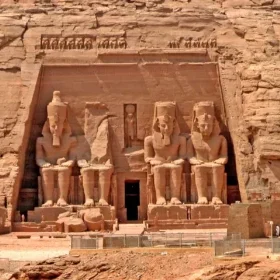Luxor, Egypt, one of the world’s most fascinating and historically rich cities, occupies the southern part of the Nile Valley in Upper Egypt. Steeped in thousands of years of history, Luxor is often referred to as the “world’s greatest open-air museum.” The city is a living testament to the grandeur of ancient Egyptian civilization and stands as a beacon for travelers and archaeologists alike.
Luxor’s Rich Heritage
Luxor sits on the site of ancient Thebes, the glorious capital of the New Kingdom of Egypt during the 16th to 11th centuries BCE. Renowned for its opulent temples, tombs, and palaces, Luxor was a center of power and culture in antiquity. The name “Luxor” itself comes from the Arabic “Al-Uqsur,” meaning “the palaces” or “the castles,” reflecting the city’s historical grandeur.
Temples of Luxor
Luxor Temple
Located on the east bank of the Nile River, the Luxor Temple is one of the most significant monuments in Egypt. Constructed during the reign of Amenhotep III (1390–1352 BCE) and later expanded by Ramses II, the temple is dedicated to the god Amun-Ra. The temple complex features a magnificent avenue lined with sphinxes, massive courtyards, and towering obelisks. The annual Opet Festival, a grand celebration of fertility and renewal, was held here, attracting worshippers and dignitaries from across Egypt.
Karnak Temple
Arguably the largest religious complex ever built, the Karnak Temple is a sprawling site that covers more than 100 hectares. Built over 2,000 years, the temple complex includes the Great Temple of Amun, the Precinct of Mut, and the Precinct of Montu. The Hypostyle Hall, with its 134 towering columns, is a breathtaking architectural marvel. Karnak was not only a religious center but also served as a treasury, administrative center, and palace for the high priests.
Tombs of Luxor
Valley of the Kings
On the west bank of the Nile, the Valley of the Kings is the final resting place of many New Kingdom pharaohs, including the famous tomb of Tutankhamun. Carved into the limestone hills, these tombs were designed to safeguard the pharaohs’ journey to the afterlife. The tombs are adorned with intricate paintings and hieroglyphs that depict the deceased’s journey through the underworld and their union with the gods. The discovery of Tutankhamun’s tomb by Howard Carter in 1922 remains one of the most significant archaeological finds in history.
Valley of the Queens
Not far from the Valley of the Kings lies the Valley of the Queens, the burial site for queens and royal children. One of the most famous tombs here is that of Queen Nefertari, wife of Ramses II. Known for its stunning wall paintings, Nefertari’s tomb is often regarded as one of the most beautiful in Egypt. The vibrant colors and detailed artwork offer a glimpse into the ancient Egyptians’ beliefs about the afterlife.
Other Notable Monuments
Hatshepsut’s Temple
The mortuary temple of Hatshepsut, one of Egypt’s few female pharaohs, is an architectural masterpiece. Located at Deir el-Bahri, the temple is built into the cliffs of the Theban hills and features terraces, colonnades, and statues. Hatshepsut’s reign was marked by prosperity, and her temple stands as a testament to her ambitious building projects and the respect she commanded.
Colossi of Memnon
These two massive stone statues of Pharaoh Amenhotep III once stood guard at the entrance to his mortuary temple. Standing at 18 meters tall, the Colossi of Memnon are all that remain of what was once the largest temple complex in ancient Thebes. The statues have fascinated travelers for centuries, especially because of the “singing” phenomenon reported by ancient Greeks and Romans—a result of the temperature changes causing the stone to emit a musical sound.
Modern Luxor
Today, Luxor is a vibrant city that seamlessly blends the ancient with the modern. It is a major tourist destination, attracting millions of visitors each year who come to marvel at its historical treasures. The city offers a range of accommodations, from luxury hotels to budget-friendly options, catering to diverse travelers. Luxor’s bustling markets, waterfront cafes, and scenic cruises on the Nile provide a perfect blend of relaxation and adventure.
Luxor Museum
For those interested in delving deeper into the city’s history, the Luxor Museum is a must-visit. The museum houses a remarkable collection of artifacts, including statues, jewelry, and pottery from different periods of Egyptian history. Highlights include the statues of Amenhotep III and the beautifully preserved reliefs from the temple of Karnak. The museum provides an informative and immersive experience, giving visitors a deeper understanding of Luxor’s rich heritage.
Cultural Significance
Luxor holds a special place in Egypt’s cultural and historical identity. The city’s monuments and artifacts are not only a testament to the ingenuity and artistry of the ancient Egyptians but also serve as a source of national pride. Luxor’s heritage sites are protected and preserved through the efforts of the Egyptian government and international organizations, ensuring that future generations can continue to appreciate and learn from these ancient wonders.
Luxor in Popular Culture
The allure of Luxor has transcended borders and influenced popular culture worldwide. The city has been featured in numerous films, documentaries, and literary works, capturing the imagination of people everywhere. From classic adventure films like “The Mummy” to documentaries by renowned historians, Luxor’s timeless appeal continues to inspire and captivate audiences.
Future Prospects
As Luxor moves into the future, efforts are being made to balance tourism with preservation. Sustainable tourism initiatives aim to protect the city’s historical sites while providing economic opportunities for the local community. The ongoing excavations and research projects in Luxor promise to uncover new discoveries, further enriching our understanding of ancient Egypt.
Conclusion
Luxor, with its awe-inspiring temples, tombs, and monuments, is a city that stands as a testament to the grandeur and ingenuity of ancient Egyptian civilization. From the majestic Luxor Temple to the serene Valley of the Kings, each site tells a story of a bygone era filled with gods, pharaohs, and eternal mysteries. As a living museum and a vibrant modern city, Luxor offers a unique journey through time, inviting travelers to explore its rich heritage and experience the magic of one of the world’s most remarkable destinations.
What fascinates you most about Luxor? Would you like to know more about a specific monument or aspect of this magnificent city?




